Settlers in the Valley
Tulbagh is one of the oldest towns in South Africa dating back to the 1700s. The valley was discovered in 1658 by Pieter Potter, a surveyor who worked for Jan van Riebeeck. In 1699 14 farmers settled in the valley, and the town started developing around 1743.

Tulbagh was the last stop for the Boers who took part in the Groot Trek before heading into the unknown interior of the country. The town was proclaimed in 1804, and was named after the former Dutch Governor, Ryk Tulbagh. In the 1860’s, the town grew exponentially and saw the extension of a railway and several roads built.
The Dutch Reformed Church was erected in 1864 and the Anglican Church in 1867. The Tulbagh district is well-known for its Rooibos tea industry. The fynbos species endemic to the region and was first marketed in 1904 by Benjamin Ginsberg.
Tulbagh Earthquake
In 1969, Tulbagh was struck by an earthquake measuring 6.4 on the Richter scale. As a result of the quake, 23 buildings had to be completely restored. The Old Dutch Reformed Church, built in 1743 to a cruciform design, is the focal point of the Oude Kerk Volksmuseum.
The church, along with three annexes in Church Street, has displays of old furniture and porcelain, as well as material on the 1969 earthquake and local geology. Other noteworthy buildings include the old Drostdy (1806), Mon Bijou (1812), the Dutch Reformed Parsonage (1769) and Ballotina, with its unusual gable.